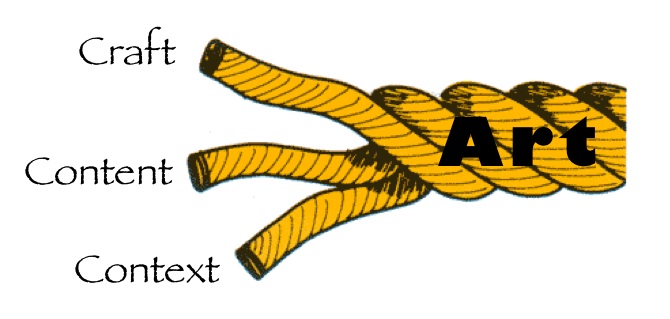Over the past several months, in a series of articles written for Transpositions, Wes Vander Lugt and I presented three crucial dynamics constituting art, seeking to render these dynamics in a way that advances educational and pastoral agendas within the sphere of theological aesthetics. Communication lies at the heart of these dynamics, which we articulated in our first post as follows:
In our perspective, the arts most fundamentally involve a person seeking through some means to communicate something to someone, somewhere and at sometime. In other words, art involves a particular craft that communicates some content in a particular context.
We then introduced a working diagram, a heuristic model, to illustrate these three dynamics: In this article, I want to outline what to me are some key theological implications of this model.
In this article, I want to outline what to me are some key theological implications of this model.
First, theological engagement with the craft of art addresses the core of human making and the process of reflecting God’s image as creators. Engaging with craft means evaluating learned skills, practiced techniques, and the use and often ingenious manipulation of forms, patterns, and conventions. Theological engagement with craft, therefore, will seek to find theologically relevant ways to evaluate the skills, techniques and styles that constitute a work of art, and discern how this craft corresponds to the content and context.
Second, theological engagement with the content of art means, among other things, asking what story a work of art expresses or symbolizes and how this perhaps illuminates or obscures revealed truths about God and his relationship with the world. For some, this might relate to what is referred to as “worldview” analysis, which I believe are the narrative-shaped perspectives that determine how we understand, experience, and live in the world. As such, art inevitably reflects the assumptions and aspirations of such storied perceptions of life. To engage with art theologically is to ask what story it tells, to what story it belongs, and how this relates to God’s Story.
Third, theological engagement with the context of art is to acknowledge that human activity and understanding are historically conditioned and situationally shaped. It is also, I believe, an approach to art that takes seriously the implications of the Incarnation. God communicates Himself not in a timeless “once upon a time” but in historical and cultural particularity. God takes the risks involved in cross-cultural communication, and by the Spirit tranposes truth into every culture. Similarly, theological engagement with the context of art will seek to appreciate the contextually salient aspects of each work while recognizing the features that resonate across time and place.
I share with Wes the desire to explicate a theology of the arts that enhances practical “traction” in the spiritual lives of Christian laity. In this regard, I’m appreciative of the recent work of William Dyrness, who articulates in his Poetic Theology: God and the Poetics of Everyday Life (Eerdmans 2011) a perspective on the arts in relation to communication and spiritual formation that reflects the heart of our project. Dyrness writes:
Art enables the world to take meaningful form; the world and its structures speak “words” in the arts. This echoes [Johann Georg] Hamann’s (and Augustine’s) suggestion that our sense perception, when it is grounded in faith, allows us to see the world as signs of a deeper reality. The Gospel as the greatest dramatic story helps us see that truth and beauty take shape not by escaping from the world but by acting within it to bring about shalom. (148-49)





Jim (and Wes), thanks for your work on this series of posts! I have enjoyed all of the questions and dialogue that have come from it.